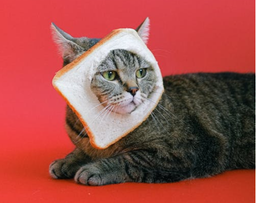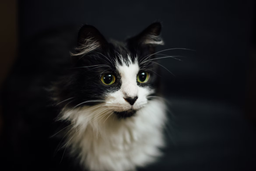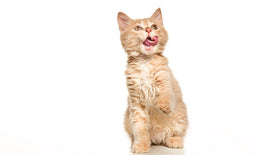Raw cat food—roaring good idea or paw choice?
For some cat parents, tailor-made food for their feline friend is the ultimate expression of care and love.
There is a growing trend towards cat food based on raw ingredients—also called a B.A.R.F (Biologically Available Raw Food) diet—the thought being that a raw food diet for cats comes as close as possible to what they would eat in the wild and what their evolution has prepared them for.
If you are looking at feeding your cat a raw diet, Untamed can help you with facts, advice, and watch-outs to make sure your kitty gets the best possible nourishment.
Raw cat food—back to the future or much ado about nothing? Untamed gives you the facts!

A happy cat makes a happy home
Source: Anna Alexes
What’s the idea behind raw food for cats?
A raw food diet for cats is based on the idea that cats’ heritage makes them ideally suited to eating uncooked, unprocessed food.
Cats have a short, acidic digestive tract that can metabolise meat, turning it into the amino acids and energy they need. Most food passes through a cat’s intestines relatively quickly—any harmful bacteria are removed before they have a chance to gain a foothold.
Supporters of feeding raw food to cats don’t like to refer to their approach as a raw meat diet—while it is the main ingredient in most cases, many raw food diets also use other ingredients to provide a balanced diet.
Raw cat food is typically homemade, using recipes either developed by cat parents or found online. In bypassing the major commercial cat food manufacturers, raw cat food proponents also claim it to be:
- Ethically sound
- Grain-free
- Suitable for sensitive cats
- Free from artificially-produced cat jelly or cat gravy
What do cats need in their diet?
Cats are obligate carnivores, meaning that they need animal-based food to get the necessary nutrients.
The basic requirements in any nutrition consist of:
- Protein
- Fat
- Carbs
- Vitamins
- Minerals
Protein
Proteins are made up of different combinations of amino acids, which are the building blocks of:
- Muscles
- Skin
- Hair
Felines also use proteins as a primary source of energy.
Of the 22 amino acids, cats can make 12 on their own but need the remaining ten in their food. Our feline friends are good at metabolising meat to release these ten—they can get them from cereals, grains, or other vegetable protein sources but need to consume considerably larger amounts of vegetable protein to cover their requirements.
All animal proteins are not equal—a cat can metabolise certain animal protein sources better than others.
The quality of an animal protein source for a cat is known as its biological value, which determines to what percentage a cat can extract amino acids. The biological values of the most common protein sources are:
|
Protein source |
Biological value (how much of a protein source a cat can use) |
|
Chicken |
98% |
|
Tuna, salmon, sardines, and shrimps |
92% |
|
Pork or ham |
87% |
|
Soya |
68% |
|
Wheatgerm, corn, sweetcorn, and other vegetable proteins |
Below 65% |

Proteins to turn your kitty into a tiger
Image (c) Untamed
Fat
Cats get essential fatty acids from the fat in their food, which help maintain cell membrane structure and regulate their healing mechanisms. Kitties also love the taste—food containing animal fat is guaranteed to be considerably tastier than meals using vegetable fat.
Fats deliver at least twice as many calories as protein, so the more fat in a cat’s food, the more calories they get. Keep in mind that cats should harvest most of their energy from proteins, and not fats. A high-fat diet could cause obesity, potentially leading to feline diabetes and arthritis.
Carbs
Cats don’t really need carbs in their diet, but small amounts can help with digestion.
If you have ever noticed your cat eating grass, it may be as a result of wanting carbs to help ease food through the gut.
High-quality, high-protein food is generally easy for kitties to digest, so many raw food cat diets do not use carbs at all. High-fibre diets are only used under specific circumstances and vet recommendations.
Vitamins
Vitamins help with the chemical reactions in your cat’s body and also help boost the immune response.
The vitamins cats need in their food are:
|
Vitamin type |
Sources |
|
Fat-soluble |
|
|
Water-soluble (B complex and C) |
|
Cats can produce vitamins C and K themselves, so these are not essential in their diet.
Minerals
Minerals are essential for:
- Bones and teeth
- Body fluid balance
- Chemical reactions in the cat’s body
Your cat needs small amounts of the following minerals in their diet:
- Calcium
- Zinc
- Magnesium
What kind of raw cat food diets are available online?
Numerous websites offer easy-to-follow complete raw cat food recipes that you can download.
Most of them are based on poultry, fish, or more exotic meats, such as rabbit, and use:
- Muscle meat
- Organ meat
- Crushed or ground bones
Many of the online diets that are available have been tested by veterinarians and deemed “complete and balanced,” meaning that they contain all the nutrients your feline companion needs for a long and healthy life.
The recipes need to be followed to the letter—any variation or deviation from the exact proportions stated could lead to an imbalance, giving your kitty too little of one nutrient and too much of another.
You can also investigate the many commercial raw food diets that are sold online or in pet stores by raw cat food suppliers.
These are pre-prepared meals that you can keep in the freezer at home and use as you need. The best of these offer you the benefits of homemade raw food without the hassle of preparation.
Keep in mind that some cats may reject the rubbery texture of freeze-dried meat altogether. According to a study on safety of raw diets, you should know about the following issues:
- Safety standards are not always as claimed—Based on an inspection of commercially available raw food during 2011-12, nearly one-fourth of the samples tested positive for bacterial contamination. Every supplier claims to follow safety standards, but whether you can trust them or not is up to you
- Cross-contamination can be dangerous—Based on hygiene standards, the correct raw food handling requires a lot of time and effort. Ignoring safety practices creates a thriving ground for foodborne pathogens, which is not only dangerous for cats, but also for humans, especially children and immunocompromised people
Another practical problem with buying raw food online is the steep price. Suppliers lure you into spending a pretty penny on “exotic meat” for “better nutrition”, when your cat can get the same nutrition from a reasonably priced wet food containing quality whole meat and organs.
How easy is it to prepare a raw food diet for cats?

Slaving away, as a good human should
Source: Myr Za
Feeding raw food to cats isn’t a simple matter of chopping up meat and plating it—raw cat food requires careful preparation.
To prepare a raw meal for your cat, you will need the following equipment:
- Meat mincer
- Poultry shears
- Glass mixing bowls
- Sealable plastic containers
- Dishwasher-proof chopping board
- Enough space in your fridge and freezer
- A plentiful supply of disposable nitrile gloves
The crucial part of your food preparation is hygiene—your recipe will almost certainly include raw meat and eggs, both of which can be breeding grounds for harmful bacteria, such as salmonella and E. coli. There is a risk of illness for your kitty and cross-contamination for you.
If you are following a recipe you have found online, you have to make sure you weigh and measure everything exactly. If you fail to do this, you may end up preparing food that:
- Doesn’t fulfil all your cat’s nutritional needs
- Varies in quality from batch to batch, possibly causing stomach upsets
If you have created your own recipe, it is sensible to seek the advice of a vet who can evaluate it for balance and completeness. The vet may recommend supplements to be added to your recipe to address any shortfalls.
What are the basic ratios a raw food diet for cats should stick to?
The balance between the major food groups in your raw food is essential to make sure your kitty stays healthy.
Proteins, fats, vitamins, and minerals all play a crucial role in your cat’s well-being, and the ratios you should aim for in a raw food diet are:
|
Nutrient type |
Ideal percentage |
|
Animal protein |
Over 50% |
|
Fat |
Under 20% |
|
Carbs/fibre |
Maximum 3% |
When you are preparing your raw cat food, you should make sure the quantities of each ingredient reflect these ratios.
The risks of raw food for cats
The topic of food safety in raw cat food is hotly debated and primarily focused on the idea of preparing and feeding raw meat.
Chicken and many other types of meat are prone to contamination with harmful bacteria, the most common of which are:
- Salmonella
- Listeria
- E. coli
Salmonella
Salmonella can infect the digestive tract and cause diarrhoea, vomiting, and dehydration.
Salmonellosis is treatable but can lead to days of discomfort for your kitty.
Listeria
Listeria is also a common harmful bacterium that thrives in uncooked chicken and will result in:
- Lethargy
- Fever
- Digestive problems
- Vomiting
Both listeriosis and salmonellosis can be fatal if undiagnosed and untreated.
E. coli
E. coli bacteria cause similar effects to salmonella and listeria.
All three of these bacteria are already present in a cat’s digestive system. Still, they are usually kept in check by the beneficial bacteria in the gut, such as Bifidus and lactobacilli.
Eating contaminated raw food leads to an imbalance, in which the harmful bacteria gain the upper hand—this is not a pleasant experience for your feline.
You should take particular care with:
- Kittens—A kitten’s immune and digestive systems may not be developed enough to cope with harmful bacteria
- Older cats—As cats get older, their bodily functions start to lose their effectiveness, meaning that infections can take a heavier toll
Other concerns
There are other areas of concern in feeding your cats a raw food diet, namely:
|
Area of concern |
Explanation |
|
Bones |
Larger bones may splinter and injure your cat’s mouth or throat, while smaller bones can get stuck in the stomach or intestines |
|
Taurine |
Cats need the amino acid taurine in their diet—it helps them maintain the health of their:
Muscle meat doesn’t contain much taurine, but liver is a good source for your cat. Your raw diet needs to ensure your feline friend gets enough taurine to cover their needs |
|
Anti-vitamins |
The anti-vitamins avidin and thiaminase are present in uncooked meat and bind vitamins together—your cat can’t metabolise them. Cooking destroys anti-vitamins |
|
Cross-contamination |
Apart from the potential risks to your cat, you are also in danger of infection as a result of handling raw ingredients while making your cat companion’s food. You need to go to great lengths at all times to keep your preparation area and yourself sanitised. Ideally, your hygiene routine should include:
|

Pretentious? Moi?
Source: Cottonbro
What should you avoid giving your cat?
Some foods should be avoided in any cat diet but particularly in a raw feline diet—the most important ingredients to steer clear of are:
- Onions and garlic
- Milk and dairy products
- Grapes and raisins
Although probably not a part of your raw cat food recipes, you should also keep your cat well away from:
- Chocolate
- Caffeine
- Alcohol
- Dough
What’s the bottom line on raw cat food?
Supporters of raw cat food claim that raw fed cats are being nourished according to the way they have evolved and that their felines are:
- Healthy
- Energetic
- Long-lived
Raw feeding for cats is a matter of choice but does involve:
- Extensive preparation
- Rigorous hygiene
- Extreme care in formulating meals
- Continuous monitoring to make sure your cat is getting all the nutrients he or she needs and is not suffering any ill effects
Feeding cats a raw diet can also work out fairly pricey as you will have to buy from top-quality suppliers who can guarantee the safety of their products.
What alternatives do you have to raw cat food?
If raw cat food is not your food of choice, there are a couple of alternatives available for you to select from:
- Dry food—Dry food comes in many varieties, but cheaper foods tend to contain a lot of cereals or grains to help bulk the kibbles. If you are looking at dry food, you should check the ingredients list and the average analysis carefully to see what is really in each bite
- Wet food—Wet cat food is also quite versatile—from pâtés to chunks in jelly. Compare products carefully, though, as many wet cat foods are full of binding agents, emulsifiers, and flavour additives
As in every area of life, you get what you pay for with commercial cat food.
While cheaper brands may not make such a dent in your bank account, you may find you have to feed your kitties more to cover their nutritional needs and keep them full of beans. More expensive foods commonly work out cheaper in the long run as the required feeding amounts tend to be smaller.
The choice is yours, but Untamed has an alternative that you should consider, with our individually-created meal plans for your feline best friend.
Untamed gives you the best of the best for your furry friend!

That’s what ahhm talkin’ bout
Image (c) Untamed
Untamed is the best way to give kitties exactly what they need—all in a delicious meal they will go wild for.
Our meals are planned to suit your cat’s preferences, and everything we produce sticks to these key principles:
- Vet-formulated
- Only human-grade ingredients
- Gently steamed
- Complete and balanced
- Hypoallergenic
Vet-formulated
All our formulas are designed in collaboration with vets to ensure they contain everything your cat needs to be happy, healthy, and full of energy.
Only human-grade ingredients
Our food contains only meat and other ingredients taken directly from the human supply chain—no “meat derivatives,” cereals, grains, or incomprehensible E-numbers that you can’t decipher.
Gently steamed
We cook our food but in a way that all the nutrients are preserved and sealed into each meal. Your kitty gets the full benefit of the great ingredients in our products!
Complete and balanced
Each meal contains exactly what your feline friend needs—including twice the amount of animal protein that other manufacturers use.
Hypoallergenic
We use natural ingredients to minimise the risk of allergic reactions. Our products are free from common allergens, artificial taste additives, or harsh preservatives. Even the most sensitive and fussy felines will love our meals. We also have tasty single-protein options in our mix—Chocka Chicken and Tuck-in Tuna.
We will create a customised diet plan for your feline based on their:
- Life stage
- Tastes
- Sensitivities
- Allergies
You will be able to see the benefits of our nutritious meals in no time at all:
- Within a week—you will notice more energy and a cleaner litter-tray
- Within two months—you will see better muscle tone and lots of vitality
- After four months—your kitty’s coat will be shinier, and fewer hairballs will be apparent
- For the rest of their life—your feline friend will naturally manage their weight by being active and eating the right amounts
Give Untamed a try and see the difference for yourself!

Personal service—just what I deserve
Image (c) Untamed
We want to give your purr-machine a chance to try our delicious food out.
After we find out a few details about them, we’ll create a tailor-made meal plan that will give your cat all the goodness they need with the flavours they’ll go mad about.
Here’s what you need to do to order our cat food online:
- Take our TRY NOW quiz and tell us more about your cat
- Check out the meal plan
- Place your order
Your kitty’s special delivery will land on your doorstep within a day, and you can watch them tuck into their new favourite food! We can replenish your pantry around the same time every month. You can always modify your order, or postpone or cancel a delivery as per your convenience! We offer free of charge cat food shipping and recyclable packaging.
Our products are easy to store and serve, you don’t have to freeze or reheat our food. Untamed tins come with a three-year shelf life, so you can stash them up for emergencies!

![Best food for Ragdoll cats in the UK [Broken Down]](http://untamed.com/cdn/shop/articles/featured_best_food_for_ragdoll_cats_uk.jpg?v=1646818249&width=256)

